
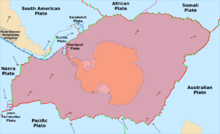
The Antarctic (/ænˈtɑːrtɪk/ or /ænˈtɑːrktɪk/, American English also /æntˈɑːrtɪk/ or /æntˈɑːrktɪk/; commonly /æˈnɑːrtɪk/) is a polar region around Earth's South Pole, opposite the Arctic region around the North Pole.
The Antarctic comprises the continent of Antarctica, the Kerguelen Plateau, and other island territories located on the Antarctic Plate or south of the Antarctic Convergence. The Antarctic region includes the ice shelves, waters, and all the island territories in the Southern Ocean situated south of the Antarctic Convergence, a zone approximately 32 to 48 km (20 to 30 mi) wide and varying in latitude seasonally. The region covers some 20 percent of the Southern Hemisphere, of which 5.5 percent (14 million km) is the surface area of the Antarctica continent itself. All of the land and ice shelves south of 60°S latitude are administered under the Antarctic Treaty System.
Biogeographically, the Antarctic realm is one of eight biogeographic realms on Earth's land surface. Climate change in Antarctica is particularly important because the melting of the Antarctic ice sheet has a high potential to add to the global sea level rise. Further, this melting also disrupts the flow of Southern Ocean overturning circulation, which would have significant effects on the local climate and marine ecosystem functioning.There is no permanent country in Antarctica .
Geography


As defined by the Antarctic Treaty System, the Antarctic region is everything south of the 60°S latitude. The Treaty area covers Antarctica and the archipelagos of the Balleny Islands, Peter I Island, Scott Island, the South Orkney Islands, and the South Shetland Islands. However, this area does not include the Antarctic Convergence, a transition zone where the cold waters of the Southern Ocean collide with the warmer waters of the north, forming a natural border to the region. Because the Convergence changes seasonally, the Convention for the Conservation of Antarctic Marine Living Resources approximates the Convergence line by joining specified points along parallels of latitude and meridians of longitude. The implementation of the convention is managed through an international commission headquartered in Hobart, Australia, by an efficient system of annual fishing quotas, licenses, and international inspectors on the fishing vessels, as well as satellite surveillance.
The islands situated between 60°S latitude parallel to the south and the Antarctic Convergence to the north and their respective 200-nautical-mile (370 km) exclusive economic zones fall under the national jurisdiction of the countries that possess them: South Georgia and the South Sandwich Islands (United Kingdom), Bouvet Island (Norway), and Heard and McDonald Islands (Australia).
Kerguelen Islands (France; also an EU Overseas territory) are situated in the Antarctic Convergence area, while the Isla Grande de Tierra del Fuego, Falkland Islands, Isla de los Estados, Hornos Island with Cape Horn, Diego Ramírez Islands, Campbell Island, Macquarie Island, Amsterdam and Saint Paul Islands, Crozet Islands, Prince Edward Islands, Gough Island, and Tristan da Cunha group remain north of the Convergence and thus outside the Antarctic region.
Ecology
See also: Antarctic realm, Antarctic microorganism, and Wildlife of AntarcticaAntarctica
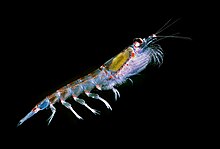
A variety of animals live in Antarctica for at least some of the year, including:
- Seals
- Penguins
- South Georgia pipits
- Albatrosses
- Antarctic petrels
- Whales
- Fish, such as Antarctic icefish, Antarctic toothfish
- Squid, including the colossal squid
- Antarctic krill

Most of the Antarctica continent is permanently covered by ice and snow, leaving less than 1 percent of the land exposed. There are only two species of flowering plant, Antarctic hair grass and Antarctic pearlwort, but a range of mosses, liverworts, lichens and macrofungi.
Sub-Antarctic Islands
Biodiversity among terrestrial flora and fauna is low on the islands: studies have theorized that the harsh climate was a major contributor towards species richness, but multiple correlations have been found with area, temperature, remoteness of islands, and food chain stability. For example, herbivorous insects are poor in number due to low plant richness, and likewise, indigenous bird numbers are related to insects, which are a major food source.
Conservation
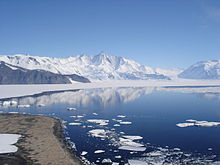
The Antarctic hosts the world's largest protected area comprising 1.07 million km, the South Georgia and the South Sandwich Islands Marine Protection Area created in 2012. The latter exceeds the surface area of another vast protected territory, the Greenland National Park's 972,000 km (375,000 sq mi). (While the Ross Sea Marine Protection Area established in 2016 is still larger at 1.55 million km, its protection is set to expire in 35 years.) To protect the area, all Antarctic ships over 500 tonnes are subject to mandatory regulations under the Polar Code, adopted by the International Maritime Organization (in force since 1 January 2017).
Climate change
This section is an excerpt from Climate change in Antarctica.
Climate change caused by greenhouse gas emissions from human activities occurs everywhere on Earth, and while Antarctica is less vulnerable to it than any other continent, climate change in Antarctica has been observed. Since 1959, there has been an average temperature increase of >0.05 °C/decade since 1957 across the continent, although it had been uneven. West Antarctica warmed by over 0.1 °C/decade from the 1950s to the 2000s, and the exposed Antarctic Peninsula has warmed by 3 °C (5.4 °F) since the mid-20th century. The colder, stabler East Antarctica had been experiencing cooling until the 2000s. Around Antarctica, the Southern Ocean has absorbed more oceanic heat than any other ocean, and has seen strong warming at depths below 2,000 m (6,600 ft). Around the West Antarctic, the ocean has warmed by 1 °C (1.8 °F) since 1955.
The warming of the Southern Ocean around Antarctica has caused the weakening or collapse of ice shelves, which float just offshore of glaciers and stabilize them. Many coastal glaciers have been losing mass and retreating, causing net-annual ice loss across Antarctica, although the East Antarctic ice sheet continues to gain ice inland. By 2100, net ice loss from Antarctica is expected to add about 11 cm (5 in) to global sea level rise. Marine ice sheet instability may cause West Antarctica to contribute tens of centimeters more if it is triggered before 2100. With higher warming, instability would be much more likely, and could double global, 21st-century sea-level rise.
The fresh, 1100–1500 billion tons (GT) per year of meltwater from the ice dilutes the saline Antarctic bottom water, weakening the lower cell of the Southern Ocean overturning circulation (SOOC). According to some research, a full collapse of the SOOC may occur at between 1.7 °C (3.1 °F) and 3 °C (5.4 °F) of global warming, although the full effects are expected to occur over multiple centuries; these include less precipitation in the Southern Hemisphere but more in the Northern Hemisphere, an eventual decline of fisheries in the Southern Ocean and a potential collapse of certain marine ecosystems. While many Antarctic species remain undiscovered, there are documented increases in Antarctic flora, and large fauna such as penguins are already having difficulty retaining suitable habitat. On ice-free land, permafrost thaws release greenhouse gases and formerly frozen pollution.
The West Antarctic ice sheet is likely to completely melt unless temperatures are reduced by 2 °C (3.6 °F) below 2020 levels. The loss of this ice sheet would take between 2,000 and 13,000 years, although several centuries of high greenhouse emissions could shorten this time to 500 years. A sea-level rise of 3.3 m (10 ft 10 in) would occur if the ice sheet collapses, leaving ice caps on the mountains, and 4.3 m (14 ft 1 in) if those ice caps also melt. Isostatic rebound may contribute an additional 1 m (3 ft 3 in) to global sea levels over another 1,000 years. The far-stabler East Antarctic ice sheet may only cause a sea-level rise of 0.5 m (1 ft 8 in) – 0.9 m (2 ft 11 in) from the current level of warming, a small fraction of the 53.3 m (175 ft) contained in the full ice sheet. With global warming of around 3 °C (5.4 °F), vulnerable areas like Wilkes Basin and Aurora Basin may collapse over around 2,000 years, potentially adding up to 6.4 m (21 ft 0 in) to sea levels. The complete melting and disappearance of the East Antarctic ice sheet would require at least 10,000 years and would only occur if global warming reaches 5 °C (9.0 °F) to 10 °C (18 °F).Society

People
The first recorded sighting of Antarctica is credited to the Spaniard Gabriel de Castilla, who reported seeing distant southern snow-capped mountains in 1603. The first Antarctic land discovered was the island of South Georgia, visited by the English merchant Anthony de la Roché in 1675.
Although such myths and speculation about a Terra Australis ("Southern Land") date back to antiquity, the first confirmed sighting of the continent of Antarctica is commonly accepted to have occurred in 1820 by the Russian expedition of Fabian Gottlieb von Bellingshausen and Mikhail Lazarev on Vostok and Mirny.
The Australian James Kerguelen Robinson (1859–1914) was the first human born in the Antarctic, on board the sealing ship Offley in the Gulf of Morbihan (Royal Sound then), Kerguelen Island on 11 March 1859. The first human born and raised on an Antarctic island was Solveig Gunbjørg Jacobsen born on 8 October 1913 in Grytviken, South Georgia.

Emilio Marcos Palma (born 7 January 1978) is an Argentine man who was the first documented person born on the continent of Antarctica at the Esperanza Base. His father, Captain Jorge Palma, was head of the Argentine Army detachment at the base. While ten people have been born in Antarctica since, Palma's birthplace remains the southernmost. In late 1977, Silvia Morella de Palma, who was then seven months pregnant, was airlifted to Esperanza Base, in order to complete her pregnancy in the base. The airlift was a part of the Argentine solutions to the sovereignty dispute over territory in Antarctica. Emilio was automatically granted Argentine citizenship by the government since his parents were both Argentine citizens, and he was born in the claimed Argentine Antarctica. Palma can be considered to be the first native Antarctican.
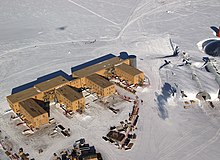
The Antarctic region had no indigenous population when first discovered, and its present inhabitants comprise a few thousand transient scientific and other personnel working on tours of duty at the several dozen research stations maintained by various countries. However, the region is visited by more than 40,000 tourists annually, the most popular destinations being the Antarctic Peninsula area (especially the South Shetland Islands) and South Georgia Island.
In December 2009, the growth of tourism, with consequences for both the ecology and the safety of the travellers in its great and remote wilderness, was noted at a conference in New Zealand by experts from signatories to the Antarctic Treaty. The definitive results of the conference were presented at the Antarctic Treaty states' meeting in Uruguay in May 2010.
Time zones
Main article: Time in AntarcticaBecause Antarctica surrounds the South Pole, it is theoretically located in all time zones. For practical purposes, time zones are usually based on territorial claims or the time zone of a station's owner country or supply base.
List of offshore islands
 A Norwegian cruise ship at Petermann Island with Kyiv Peninsula of Graham Land in the background
A Norwegian cruise ship at Petermann Island with Kyiv Peninsula of Graham Land in the background
North of 60°S latitude

 Bouvet Island (Norway)
Bouvet Island (Norway) Heard Island and McDonald Islands (Australia)
Heard Island and McDonald Islands (Australia)
 Kerguelen Islands (France)
Kerguelen Islands (France) South Georgia and the South Sandwich Islands (United Kingdom)
South Georgia and the South Sandwich Islands (United Kingdom)
South of 60°S latitude
 Balleny Islands (Antarctic Treaty System)
Balleny Islands (Antarctic Treaty System) Peter I Island (Antarctic Treaty System)
Peter I Island (Antarctic Treaty System) Scott Island (Antarctic Treaty System)
Scott Island (Antarctic Treaty System) South Orkney Islands (Antarctic Treaty System)
South Orkney Islands (Antarctic Treaty System) South Shetland Islands (Antarctic Treaty System)
South Shetland Islands (Antarctic Treaty System)
See also
Notes
- The word was originally pronounced without the first /k/, but the spelling pronunciation has become common and is often considered more correct. The pronunciation without the first k sound and the first t sound is however widespread and a typical phenomenon of English in many other similar words too. The "c" was added to the spelling for etymological reasons and then began to be pronounced, but (as with other spelling pronunciations) at first only by less educated people.
References
- Publishers, HarperCollins. "The American Heritage Dictionary entry: Antarctica". www.ahdictionary.com. Archived from the original on 8 December 2015.
- Crystal, David (2006). The Fight for English. Oxford University Press. p. 172. ISBN 978-0-19-920764-0.
- Harper, Douglas. "Antarctic". Online Etymology Dictionary. Archived from the original on 11 January 2012. Retrieved 16 November 2011.
- "Scientific Committee on Antarctic Research website". SCAR. Archived from the original on 14 December 2013.
- "The Antarctic Treaty | NSF". www.nsf.gov. National Science Foundation. Archived from the original on 11 May 2013. Retrieved 7 October 2020.
- "Commission for the Conservation of Antarctic Marine Living Resources – Department of Agriculture". www.agriculture.gov.au. Archived from the original on 20 September 2020. Retrieved 7 October 2020.
- "Convention for the Conservation of Antarctic Marine Living Resources" (PDF). Archived from the original (PDF) on 5 May 2010.
- "Schedule of Conservation Measures in Force 2023/24" (PDF). CCAMLR. Archived (PDF) from the original on 8 February 2024. Retrieved 15 April 2024.
- "Polar Wildlife". British Antarctic Survey. Natural Environment Research Council. Archived from the original on 1 August 2023.
- Vanessa Woods (14 October 2011). "Antarctic wildlife". Commonwealth Scientific and Industrial Research Organisation. Archived from the original on 14 December 2013. Retrieved 20 November 2012.
- "Plants". British Antarctic Survey. Natural Environment Research Council. Archived from the original on 26 September 2023.
- Chown; Gremmen; Gaston (1998). "Ecological Biogeography of Southern Ocean Islands: Species-Area Relationships, Human Impacts, and Conservation" (PDF). The American Naturalist. 152 (4): 562–75. doi:10.2307/2463357. ISSN 0003-0147. JSTOR 2463357. PMID 18811364.
- "SGSSI Marine Protection Area (Management Plan)" (PDF). Archived from the original (PDF) on 29 October 2016.
- "Greenland in figures 2009". Statistics Greenland. 2009. Archived from the original on 28 April 2010.
- CCAMLR to create world's largest Marine Protected Area. CCAMLR Website
- Slezak, Michael (26 October 2016). "World's largest marine park created in Ross Sea in Antarctica in landmark deal". The Guardian. Archived from the original on 28 October 2016. Retrieved 28 October 2016.
- "Shipping in polar waters". IMO. Archived from the original on 2 August 2021. Retrieved 2 August 2021.
- "The Polar Code, One Year On". The Maritime Executive. Archived from the original on 2 August 2021. Retrieved 2 August 2021.
- Singh, Hansi A.; Polvani, Lorenzo M. (10 January 2020). "Low Antarctic continental climate sensitivity due to high ice sheet orography". npj Climate and Atmospheric Science. 3 (1): 39. Bibcode:2020npCAS...3...39S. doi:10.1038/s41612-020-00143-w. S2CID 222179485.
- Steig, Eric; Schneider, David; Rutherford, Scott; Mann, Michael E.; Comiso, Josefino; Shindell, Drew (1 January 2009). "Warming of the Antarctic ice-sheet surface since the 1957 International Geophysical Year". Arts & Sciences Faculty Publications.
- ^ "Impacts of climate change". Discovering Antarctica. Retrieved 15 May 2022.
- Clem, Kyle R.; Fogt, Ryan L.; Turner, John; Lintner, Benjamin R.; Marshall, Gareth J.; Miller, James R.; Renwick, James A. (August 2020). "Record warming at the South Pole during the past three decades". Nature Climate Change. 10 (8): 762–770. Bibcode:2020NatCC..10..762C. doi:10.1038/s41558-020-0815-z. ISSN 1758-6798. S2CID 220261150.
- Xin, Meijiao; Clem, Kyle R; Turner, John; Stammerjohn, Sharon E; Zhu, Jiang; Cai, Wenju; Li, Xichen (2 June 2023). "West-warming East-cooling trend over Antarctica reversed since early 21st century driven by large-scale circulation variation". Environmental Research Letters. 18 (6): 064034. doi:10.1088/1748-9326/acd8d4.
- Bourgeois, Timothée; Goris, Nadine; Schwinger, Jörg; Tjiputra, Jerry F. (17 January 2022). "Stratification constrains future heat and carbon uptake in the Southern Ocean between 30°S and 55°S". Nature Communications. 13 (1): 340. Bibcode:2022NatCo..13..340B. doi:10.1038/s41467-022-27979-5. PMC 8764023. PMID 35039511.
- ^ Fox-Kemper, B.; Hewitt, H.T.; Xiao, C.; Aðalgeirsdóttir, G.; Drijfhout, S.S.; Edwards, T.L.; Golledge, N.R.; Hemer, M.; Kopp, R.E.; Krinner, G.; Mix, A. (2021). Masson-Delmotte, V.; Zhai, P.; Pirani, A.; Connors, S.L.; Péan, C.; Berger, S.; Caud, N.; Chen, Y.; Goldfarb, L. (eds.). "Chapter 9: Ocean, Cryosphere and Sea Level Change" (PDF). Climate Change 2021: The Physical Science Basis. Contribution of Working Group I to the Sixth Assessment Report of the Intergovernmental Panel on Climate Change. Cambridge University Press, Cambridge, UK and New York, NY, USA: 1270–1272.
- Nauels, Alexander; Rogelj, Joeri; Schleussner, Carl-Friedrich; Meinshausen, Malte; Mengel, Matthias (1 November 2017). "Linking sea level rise and socioeconomic indicators under the Shared Socioeconomic Pathways". Environmental Research Letters. 12 (11): 114002. Bibcode:2017ERL....12k4002N. doi:10.1088/1748-9326/aa92b6. hdl:20.500.11850/230713.
- L. Bamber, Jonathan; Oppenheimer, Michael; E. Kopp, Robert; P. Aspinall, Willy; M. Cooke, Roger (May 2019). "Ice sheet contributions to future sea-level rise from structured expert judgment". Proceedings of the National Academy of Sciences. 116 (23): 11195–11200. Bibcode:2019PNAS..11611195B. doi:10.1073/pnas.1817205116. PMC 6561295. PMID 31110015.
- Horton, Benjamin P.; Khan, Nicole S.; Cahill, Niamh; Lee, Janice S. H.; Shaw, Timothy A.; Garner, Andra J.; Kemp, Andrew C.; Engelhart, Simon E.; Rahmstorf, Stefan (8 May 2020). "Estimating global mean sea-level rise and its uncertainties by 2100 and 2300 from an expert survey". npj Climate and Atmospheric Science. 3 (1): 18. Bibcode:2020npCAS...3...18H. doi:10.1038/s41612-020-0121-5. hdl:10356/143900. S2CID 218541055.
- Silvano, Alessandro; Rintoul, Stephen Rich; Peña-Molino, Beatriz; Hobbs, William Richard; van Wijk, Esmee; Aoki, Shigeru; Tamura, Takeshi; Williams, Guy Darvall (18 April 2018). "Freshening by glacial meltwater enhances the melting of ice shelves and reduces the formation of Antarctic Bottom Water". Science Advances. 4 (4): eaap9467. doi:10.1126/sciadv.aap9467. PMC 5906079. PMID 29675467.
- Pan, Xianliang L.; Li, Bofeng F.; Watanabe, Yutaka W. (10 January 2022). "Intense ocean freshening from melting glacier around the Antarctica during early twenty-first century". Scientific Reports. 12 (1): 383. Bibcode:2022NatSR..12..383P. doi:10.1038/s41598-021-04231-6. ISSN 2045-2322. PMC 8748732. PMID 35013425.
- Lenton, T. M.; Armstrong McKay, D.I.; Loriani, S.; Abrams, J.F.; Lade, S.J.; Donges, J.F.; Milkoreit, M.; Powell, T.; Smith, S.R.; Zimm, C.; Buxton, J.E.; Daube, Bruce C.; Krummel, Paul B.; Loh, Zoë; Luijkx, Ingrid T. (2023). The Global Tipping Points Report 2023 (Report). University of Exeter.
- Logan, Tyne (29 March 2023). "Landmark study projects 'dramatic' changes to Southern Ocean by 2050". ABC News.
- Roland, Thomas P.; Bartlett, Oliver T.; Charman, Dan J.; Anderson, Karen; Hodgson, Dominic A.; Amesbury, Matthew J.; Maclean, Ilya; Fretwell, Peter T.; Fleming, Andrew (4 October 2024). "Sustained greening of the Antarctic Peninsula observed from satellites". Nature Geoscience: 1–6. doi:10.1038/s41561-024-01564-5. ISSN 1752-0908.
- Potapowicz, Joanna; Szumińska, Danuta; Szopińska, Małgorzata; Polkowska, Żaneta (15 February 2019). "The influence of global climate change on the environmental fate of anthropogenic pollution released from the permafrost: Part I. Case study of Antarctica". Science of the Total Environment. 651 (Pt 1): 1534–1548. doi:10.1016/j.scitotenv.2018.09.168. ISSN 0048-9697. PMID 30360282. S2CID 53093132.
- Carlson, Anders E; Walczak, Maureen H; Beard, Brian L; Laffin, Matthew K; Stoner, Joseph S; Hatfield, Robert G (10 December 2018). Absence of the West Antarctic ice sheet during the last interglaciation. American Geophysical Union Fall Meeting.
- Lau, Sally C. Y.; Wilson, Nerida G.; Golledge, Nicholas R.; Naish, Tim R.; Watts, Phillip C.; Silva, Catarina N. S.; Cooke, Ira R.; Allcock, A. Louise; Mark, Felix C.; Linse, Katrin (21 December 2023). "Genomic evidence for West Antarctic Ice Sheet collapse during the Last Interglacial" (PDF). Science. 382 (6677): 1384–1389. Bibcode:2023Sci...382.1384L. doi:10.1126/science.ade0664. PMID 38127761. S2CID 266436146.
- A. Naughten, Kaitlin; R. Holland, Paul; De Rydt, Jan (23 October 2023). "Unavoidable future increase in West Antarctic ice-shelf melting over the twenty-first century". Nature Climate Change. 13 (11): 1222–1228. Bibcode:2023NatCC..13.1222N. doi:10.1038/s41558-023-01818-x. S2CID 264476246.
- Garbe, Julius; Albrecht, Torsten; Levermann, Anders; Donges, Jonathan F.; Winkelmann, Ricarda (2020). "The hysteresis of the Antarctic Ice Sheet". Nature. 585 (7826): 538–544. Bibcode:2020Natur.585..538G. doi:10.1038/s41586-020-2727-5. PMID 32968257. S2CID 221885420.
- ^ Armstrong McKay, David; Abrams, Jesse; Winkelmann, Ricarda; Sakschewski, Boris; Loriani, Sina; Fetzer, Ingo; Cornell, Sarah; Rockström, Johan; Staal, Arie; Lenton, Timothy (9 September 2022). "Exceeding 1.5 °C global warming could trigger multiple climate tipping points". Science. 377 (6611): eabn7950. doi:10.1126/science.abn7950. hdl:10871/131584. ISSN 0036-8075. PMID 36074831. S2CID 252161375.
- ^ Armstrong McKay, David (9 September 2022). "Exceeding 1.5 °C global warming could trigger multiple climate tipping points – paper explainer". climatetippingpoints.info. Retrieved 2 October 2022.
- ^ Pan, Linda; Powell, Evelyn M.; Latychev, Konstantin; Mitrovica, Jerry X.; Creveling, Jessica R.; Gomez, Natalya; Hoggard, Mark J.; Clark, Peter U. (30 April 2021). "Rapid postglacial rebound amplifies global sea level rise following West Antarctic Ice Sheet collapse". Science Advances. 7 (18). Bibcode:2021SciA....7.7787P. doi:10.1126/sciadv.abf7787. PMC 8087405. PMID 33931453.
- Fretwell, P.; et al. (28 February 2013). "Bedmap2: improved ice bed, surface and thickness datasets for Antarctica" (PDF). The Cryosphere. 7 (1): 390. Bibcode:2013TCry....7..375F. doi:10.5194/tc-7-375-2013. S2CID 13129041. Archived (PDF) from the original on 16 February 2020. Retrieved 6 January 2014.
- Crotti, Ilaria; Quiquet, Aurélien; Landais, Amaelle; Stenni, Barbara; Wilson, David J.; Severi, Mirko; Mulvaney, Robert; Wilhelms, Frank; Barbante, Carlo; Frezzotti, Massimo (10 September 2022). "Wilkes subglacial basin ice sheet response to Southern Ocean warming during late Pleistocene interglacials". Nature Communications. 13 (1): 5328. Bibcode:2022NatCo..13.5328C. doi:10.1038/s41467-022-32847-3. PMC 9464198. PMID 36088458.
- Robinson, James (1906). "Appendix B: Log of the Offley". In Cerchi, D. (ed.). Reminiscences (Report). Hobart, Tasmania, AU: Archives Office of Tasmania. pp. 98–99. Archived from the original on 6 February 2012.
- L. Ivanov and N. Ivanova. The World of Antarctica. Archived 1 November 2022 at the Wayback Machine Generis Publishing, 2022. 241 pp. ISBN 979-8-88676-403-1
- Headland, Robert (1984). The Island of South Georgia. Cambridge: Cambridge University Press. ISBN 9780521424745.
- "Emilio Palma, argentino y "Adán" de la Antártida | Información General". www.diarioc.com.ar. Archived from the original on 25 February 2021. Retrieved 2 April 2021.
- "IAATO tourist statistics 2007/08" (PDF). Archived (PDF) from the original on 1 August 2013. Retrieved 20 July 2009.
- Antarctic Nations Considering New Controls On Ships Amid Tourism Explosion. Archived 18 January 2012 at the Wayback Machine Ray Lilley, The Associated Press, 8 December 2009.
- National Geographic Spciety (14 August 2012). "South Pole". National Geographic Society. Archived from the original on 28 March 2022. Retrieved 9 April 2022.
Further reading
Main article: Bibliography of Antarctica- Krupnik, Igor; Michael A. Lang; Scott E. Miller (eds). Smithsonian at the Poles: Contributions to International Polar Year Science. Washington, D.C.: Smithsonian Institution Scholarly Press, 2009.
External links
- British Services Antarctic Expedition 2012
- Committee for Environmental Protection of Antarctica
- Secretariat of the Antarctic Treaty
- CCAMLR Commission
- Antarctic Heritage Trusts
- International Association of Antarctica Tour Operators
- Map of the Antarctic Convergence
- The South Atlantic and Subantarctic Islands
- Ushuaia is the most popular gateway to Antarctica
| Antarctica | ||||||||
|---|---|---|---|---|---|---|---|---|
| Geography |
|  | ||||||
| History | ||||||||
| Politics | ||||||||
| Society | ||||||||
| Famous explorers | ||||||||
| Earth's polar regions | |
|---|---|
| Antarctic | |
| Arctic | |
| Territorial claims in Antarctica | ||
|---|---|---|
| Claims | 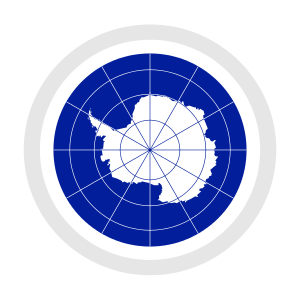 | |
| Former claims |
| |
| Unclaimed | ||
| Unrecognized and Proposed claims |
| |
| Peri-Antarctic countries and overseas territories | |
|---|---|
| "Peri-Antarctic" (meaning "close to the Antarctic") does not include territorial claims in Antarctica itself. |
| Polar exploration | |||||||||||||||
|---|---|---|---|---|---|---|---|---|---|---|---|---|---|---|---|
| |||||||||||||||
| |||||||||||||||
90°00′S 00°00′W / 90.000°S -0.000°E / -90.000; -0.000
Categories: